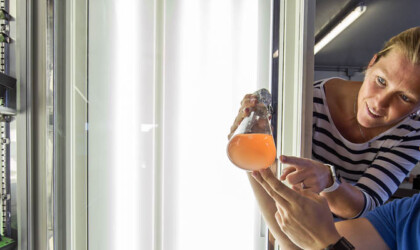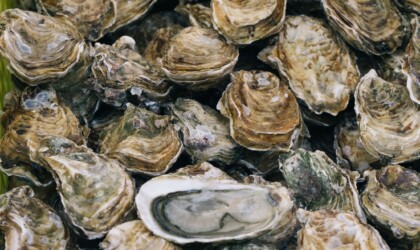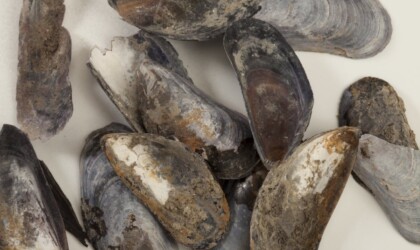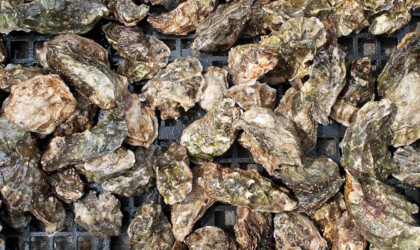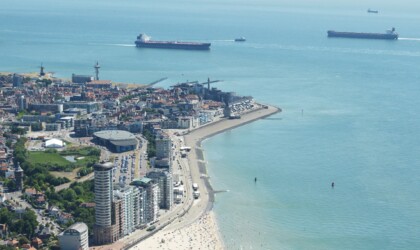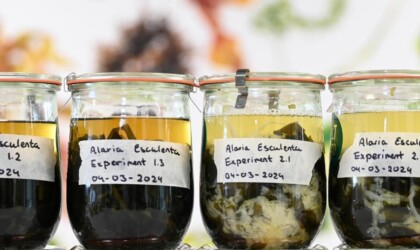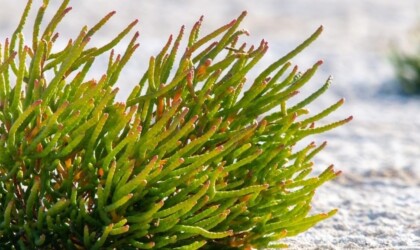To date, oysters in the Netherlands are cultivated at the bottom of shallow waters (i.e. bottom cultivation) or on so-called cultivation tables. Bottom culture oysters are moved twice a year to ensure ideal conditions for growth and to cope with silting. These operations require a lot of vessel movements and manual labour. The cultivation operations can also cause unwanted pressure on the environment.
Consequently, stricter regulations are expected to reduce the space where oysters can be grown. In addition, predators, oxygen depletion and weather conditions are a hindrance and growing concern for bottom cultivation. Alternative production methods based on cultivation tables require a relatively large amount of manual labour in comparison; sometimes oysters have to be shucked up to 15 times a year for the purpose of obtaining a nice shape shell. In addition, cultivation tables also lead to tension in drying areas that are also home to many foraging migratory birds.
Floating systems
This is the reason why this project aims to develop a new cultivation method based on floating systems that allows sustainable cultivation of oysters in tidal environments, with the added advantage of minimising manual labour through (mechanical) automation. The basis of the proposed 'flip farm system' consists of several floating baskets in which the oysters are grown. The baskets are connected by a line. Several buoys and anchors (i.e. grid) keep the breeding baskets at the intended location and height in the water column (matched to optimal algae concentrations). A methodology will be developed to turn the baskets regularly (with minimal labour) for the purpose of obtaining an attractive oyster shape; this will investigate how to efficiently make use of tidal action. In the process, an innovative system will be developed to classify and sort oysters in a smart and automated manner during the process, both during cultivation and at harvest time.
Summary
In summary, the envisaged flip farm system consists of three components, which will be developed and demonstrated within this project:
- Floating system: The basis of the new breeding system will be a number of floating oyster baskets floating in the upper part of the water column (oyster gully). This is where most of the nutrition (naturally occurring algae) is located and therefore rapid growth occurs. In addition, the floating principle will allow for better control of the cultivation, i.e. less dependent on the state of the tide, as is the case with cultivation tables.
- Flip system: To obtain a nice shell shape (which has a lot of market value), the idea is to flip these floating systems with a flip system periodically and fully automatically. This will remove faeces and sharp parts from the shell. The starting point is to let this tilting process take place on a natural basis with the help of tide/current/wind.
- Sorting technology: Within this project, new technical sorting technology is being developed to achieve accurate and automated classification of oysters (in all breeding phases) in the breeding process, enabling efficient and smart sorting. Through a pilot in the Waterdunen nature reserve, the project participants J.P. Dhooge BV and HZ University of Applied Sciences aim to demonstrate that:
- Impact on environment and nature of the new methodology is very low;
- The system has potential to be further rolled out (in a modular way) in other tidal environments and could serve as a possible alternative to bottom cultivation;
- High-quality oysters can be grown in a (cost-)efficient and automated way using this method.
Double levee
The system will thus offer the oyster sector opportunities to become more sustainable in economically interesting ways; fewer ship movements, less impact on the environment and nature and less manual labour required. In addition, the project partners see opportunities to link the production activity to multiple use of space and coastal protection technology or 'Double Levee' principle. The space between the two levees will have tides to which this production process can be tailored extremely efficiently. The limited nature impact of the farming process also allows for multiple space use in Natura-2000 areas based on this farming system. The intended flip-farm system thus enables the oyster sector to produce in a commercially interesting and sustainable way in harmony with nature, recreation and the coastal defence of the Netherlands.
The findings will be announced after the end of the project, expected in December 2024, and will be published on the HZ University of Applied Sciences website, among others. Here, the results will remain findable for at least five years after the end of the project. Also, the findings of this project are available free of charge on request to all companies active in the sector or subsector concerned.
The project was co-funded by Sustainable Fisheries and Aquaculture Grant Scheme (SDVA).

